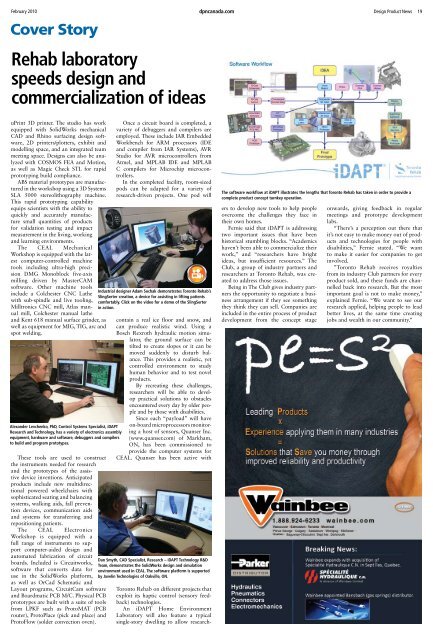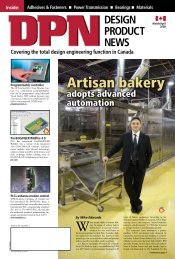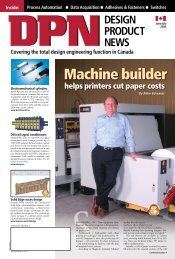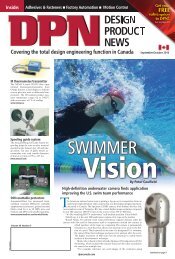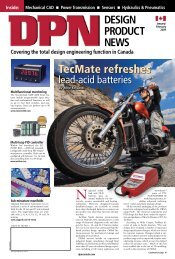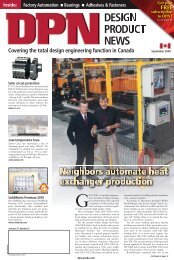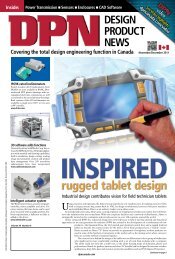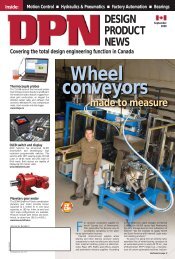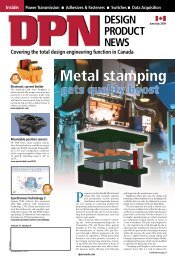Complete DPN February 2010 - Design Product News
Complete DPN February 2010 - Design Product News
Complete DPN February 2010 - Design Product News
Create successful ePaper yourself
Turn your PDF publications into a flip-book with our unique Google optimized e-Paper software.
<strong>February</strong> <strong>2010</strong><br />
Cover Story<br />
rehab laboratory<br />
speeds design and<br />
commercialization of ideas<br />
uPrint 3D printer. The studio has work<br />
equipped with SolidWorks mechanical<br />
CAD and Rhino surfacing design software,<br />
2D printers/plotters, exhibit and<br />
modelling space, and an integrated team<br />
meeting space. <strong>Design</strong>s can also be analyzed<br />
with COSMOS FEA and Motion,<br />
as well as Magic Check STL for rapid<br />
prototyping build compliance.<br />
ABS material prototypes are manufactured<br />
in the workshop using a 3D Systems<br />
SLA 5000 stereolithography machine.<br />
This rapid prototyping capability<br />
equips scientists with the ability to<br />
quickly and accurately manufacture<br />
small quantities of products<br />
for validation testing and impact<br />
measurement in the living, working<br />
and learning environments.<br />
The CEAL Mechanical<br />
Workshop is equipped with the latest<br />
computer-controlled machine<br />
tools including ultra-high precision<br />
DMG Monoblock five-axis<br />
milling driven by MasterCAM<br />
software. Other machine tools<br />
include a Colchester CNC Lathe<br />
with sub-spindle and live tooling,<br />
Milltronics CNC mill, Atlas manual<br />
mill, Colchester manual lathe<br />
and Kent 618 manual surface grinder, as<br />
well as equipment for MIG, TIG, arc and<br />
spot welding.<br />
Alexander Levchenko, PhD, control systems specialist, iDAPt<br />
research and technology, has a variety of electronics assembly<br />
equipment, hardware and software, debuggers and compilers<br />
to build and program prototypes.<br />
These tools are used to construct<br />
the instruments needed for research<br />
and the prototypes of the assistive<br />
device inventions. Anticipated<br />
products include new multidirectional<br />
powered wheelchairs with<br />
sophisticated seating and balancing<br />
systems, walking aids, fall prevention<br />
devices, communication aids<br />
and systems for transferring and<br />
repositioning patients.<br />
The CEAL Electronics<br />
Workshop is equipped with a<br />
full range of instruments to support<br />
computer-aided design and<br />
automated fabrication of circuit<br />
boards. Included is Circuitworks,<br />
software that converts data for<br />
use in the SolidWorks platform,<br />
as well as OrCad Schematic and<br />
Layout programs, CircuitCam software<br />
and Boardmatic PCB M/C. Physical PCB<br />
prototypes are built with a suite of tools<br />
from LPKF such as ProtoMAT (PCB<br />
router), ProtoPlace (pick and place) and<br />
ProtoFlow (solder convection oven).<br />
Once a circuit board is completed, a<br />
variety of debuggers and compilers are<br />
employed. These include IAR Embedded<br />
Workbench for ARM processors (IDE<br />
and compiler from IAR Systems), AVR<br />
Studio for AVR microcontrollers from<br />
Atmel, and MPLAB IDE and MPLAB<br />
C compilers for Microchip microcontrollers.<br />
In the completed facility, room-sized<br />
pods can be adapted for a variety of<br />
research-driven projects. One pod will<br />
industrial designer Adam sochak demonstrates toronto rehab’s<br />
slingserter creation, a device for assisting in lifting patients<br />
comfortably. click on the video for a demo of the slingserter<br />
in action.<br />
contain a real ice floor and snow, and<br />
can produce realistic wind. Using a<br />
Bosch Rexroth hydraulic motion simulator,<br />
the ground surface can be<br />
tilted to create slopes or it can be<br />
moved suddenly to disturb balance.<br />
This provides a realistic, yet<br />
controlled environment to study<br />
human behavior and to test novel<br />
products.<br />
By recreating these challenges,<br />
researchers will be able to develop<br />
practical solutions to obstacles<br />
encountered every day by older people<br />
and by those with disabilities.<br />
Since each “payload” will have<br />
on-board microprocessors monitoring<br />
a host of sensors, Quanser Inc.<br />
(www.quanser.com) of Markham,<br />
ON, has been commissioned to<br />
provide the computer systems for<br />
CEAL. Quanser has been active with<br />
Dan smyth, cAD specialist, research – iDAPt technology r&D<br />
team, demonstrates the solidworks design and simulation<br />
environment used in ceAL. the software platform is supported<br />
by Javelin technologies of oakville, on.<br />
Toronto Rehab on different projects that<br />
exploit its haptic control (sensory feedback)<br />
technologies.<br />
An iDAPT Home Environment<br />
Laboratory will also feature a typical<br />
single-story dwelling to allow research-<br />
dpncanada.com<br />
ers to develop new tools to help people<br />
overcome the challenges they face in<br />
their own homes.<br />
Fernie said that iDAPT is addressing<br />
two important issues that have been<br />
historical stumbling blocks. “Academics<br />
haven’t been able to commercialize their<br />
work,” and “researchers have bright<br />
ideas, but insufficient resources.” The<br />
Club, a group of industry partners and<br />
researchers at Toronto Rehab, was created<br />
to address those issues.<br />
Being in The Club gives industry partners<br />
the opportunity to negotiate a business<br />
arrangement if they see something<br />
they think they can sell. Companies are<br />
included in the entire process of product<br />
development from the concept stage<br />
<strong>Design</strong> <strong>Product</strong> <strong>News</strong> 19<br />
the software workflow at iDAPt illustrates the lengths that toronto rehab has taken in order to provide a<br />
complete product concept turnkey operation.<br />
onwards, giving feedback in regular<br />
meetings and prototype development<br />
labs.<br />
“There’s a perception out there that<br />
it’s not easy to make money out of products<br />
and technologies for people with<br />
disabilities,” Fernie stated. “We want<br />
to make it easier for companies to get<br />
involved.<br />
”Toronto Rehab receives royalties<br />
from its industry Club partners for every<br />
product sold, and these funds are channelled<br />
back into research. But the most<br />
important goal is not to make money,”<br />
explained Fernie. “We want to see our<br />
research applied, helping people to lead<br />
better lives, at the same time creating<br />
jobs and wealth in our community.”<br />
Wainbee_<strong>DPN</strong>_Feb10.indd 1 1/25/10 10:06:12 AM


